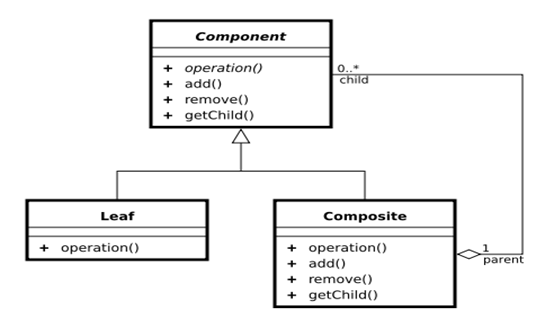概念
Composite模式也叫组合模式,是构造型的设计模式之一。通过递归手段来构造树形的对象结构,并可以通过一个对象来访问整个对象树。
角色和职责

Component (树形结构的节点抽象)
- 为所有的对象定义统一的接口(公共属性,行为等的定义)
- 提供管理子节点对象的接口方法
- [可选]提供管理父节点对象的接口方法
Leaf (树形结构的叶节点)
Component的实现子类
Composite(树形结构的枝节点)
Component的实现子类
适用于:
单个对象和组合对象的使用具有一致性。将对象组合成树形结构以表示“部分--整体”
案例
//实现一个目录结构,如下:
C:
111dir
222dir
222.txt
aaa.txt
#include <iostream>
using namespace std;
#include "list"
#include "string"
//
class IFile
{
public:
virtual void display() = 0;
virtual int add(IFile *ifile) = 0;
virtual int remove(IFile *ifile) = 0;
virtual list<IFile *>* getChild() = 0;
protected:
private:
};
class File : public IFile
{
public:
File(string name)
{
m_list = NULL;
m_name = "";
m_name = name;
}
~File()
{
if (m_list != NULL)
{
delete m_list;
}
}
virtual void display()
{
cout << m_name << endl;
}
virtual int add(IFile *ifile)
{
return -1;
}
virtual int remove(IFile *ifile)
{
return -1;
}
virtual list<IFile *>* getChild()
{
return NULL;
}
private:
list<IFile *> * m_list;
string m_name;
};
class Folder : public IFile
{
public:
Folder(string name)
{
m_name = name;
m_list = new list<IFile *>;
}
~Folder()
{
if (m_list == NULL)
{
delete m_list;
}
}
virtual void display()
{
cout << m_name << endl;
}
virtual int add(IFile *ifile)
{
m_list->push_back(ifile);
return 0;
}
virtual int remove(IFile *ifile)
{
m_list->remove(ifile);
return 0;
}
virtual list<IFile *>* getChild()
{
return m_list;
}
private:
list<IFile *> * m_list;
string m_name;
};
void showTree(IFile *ifile, int level)
{
list<IFile *> *l = NULL;
int i = 0;
for (i=0; i<level; i++)
{
printf("\t");
}
ifile->display();
l = ifile->getChild();
if (l != NULL)
{
for (list<IFile *>::iterator it=l->begin(); it!=l->end(); it++)
{
if ( (*it)->getChild() == NULL)
{
for (i=0; i<=level; i++) //注意 <=
{
printf("\t");
}
(*it)->display();
}
else
{
showTree((*it), level + 1);
}
}
}
}
void main()
{
Folder *root = new Folder("C:");
Folder *dir1 = new Folder("111dir");
File *txt1 = new File("aaa.txt");
Folder *dir12 = new Folder("222dir");
//dir12->display();
File *txt12 = new File("222.txt");
//txt12->display();
root->display();
root->add(dir1);
root->add(txt1);
dir1->add(dir12);
dir1->add(txt12);
/*
list<IFile *> *l = dir1->getChild();
for (list<IFile *>::iterator it=l->begin(); it!=l->end(); it++)
{
(*it)->display();
}
*/
//开发一个递归函数 现在根结点下的所有子结点
cout << "测试递归函数" << endl;
showTree(root, 0);
delete txt12;
delete dir12;
delete dir1;
delete txt1;
delete root;
cout<<"hello..."<<endl;
system("pause");
return ;
}